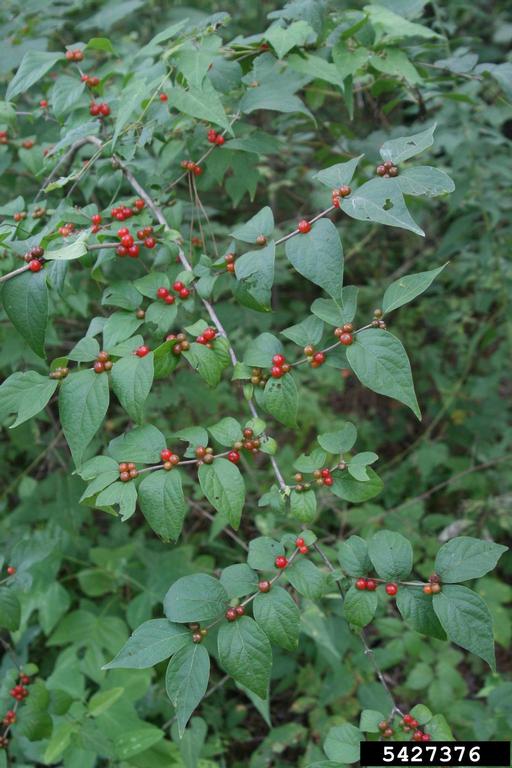 Amur honeysuckle (Lonicera maackii) is one of four species of non-native honeysuckle listed as Restricted Noxious Weeds in Minnesota. It is native to Asia and was introduced to North America as an ornamental plant that was then widely planted for wildlife and erosion control.
Amur honeysuckle (Lonicera maackii) is one of four species of non-native honeysuckle listed as Restricted Noxious Weeds in Minnesota. It is native to Asia and was introduced to North America as an ornamental plant that was then widely planted for wildlife and erosion control.Amur honeysuckle is a deciduous shrub that can grow 15-20 feet tall. The leaves are oval shaped, 2-3 inches long covered with downy hairs. The flowers are pinkish to white, tubular, and less than an inch long. The fruit are round red to orange-red berries that develop in late summer and persist throughout the winter.
Amur honeysuckle can rapidly invade and overtake a site by crowding out and shading native species. It is adaptable to a variety of conditions from sun to deep shade and wet to dry soils. The abundant fruit are attractive to birds, which will eat the fruit and spread the seed to new areas. Amur honeysuckle will grow new shoots from suckers. It can outcompete native species by suppressing the regeneration of native tree seedlings, and alter the habitat by depleting soil moisture and nutrients. Though it has become invasive in eastern and nearby states, only a few naturalizing Amur honeysuckle infestations have been reported in Minnesota.
Amur honeysuckle is a Restricted Noxious Weed in Minnesota. Although landowners are ultimately not required to control or eradicate Restricted Noxious Weeds on their properties, they are encouraged to manage Amur honeysuckle appropriately to prevent future spread of this species and degradation of native habitats. Several management options are available for Amur honeysuckle. For all options, infestation sites will need to be monitored and treated repeatedly until the seedbanks are depleted.
- Do not plant Amur honeysuckle as an ornamental and remove existing plants on your property
- Young plants can be pulled by hand. Mature plants can be removed by using a weed wrench tool or by repeated cutting. Keep in mind that physical removal in this manner can disturb soils and result in reinvasion or resprouting of honeysuckles and other exotics.
- Prescribed burning can be an effective tool to control infestations in combination with other techniques. Spring burning will kill seedlings and the tops of mature plants. Make sure to contact the Minnesota Department of Natural Resources to learn more about control burning practices and regulations.
- Foliar and cut-stem application of herbicides that translocate their active ingredients into the root system can be very effective. Treatments will need to be repeated for several years to eradicate a population. If using herbicide treatments, check with your local University of Minnesota Extension agent, co-op, or certified landscape care expert for assistance and recommendations. There are several businesses throughout the state with certified herbicide applicators that can be hired to perform chemical applications.

